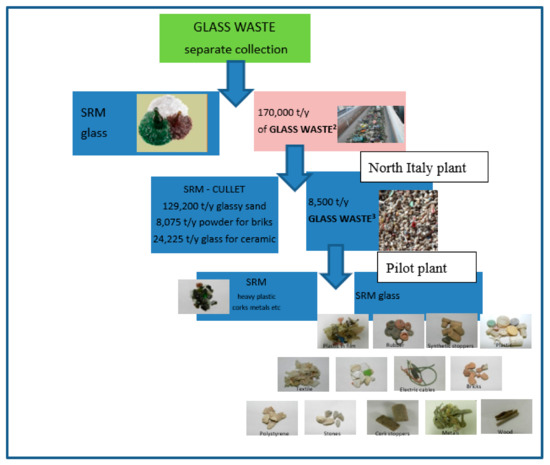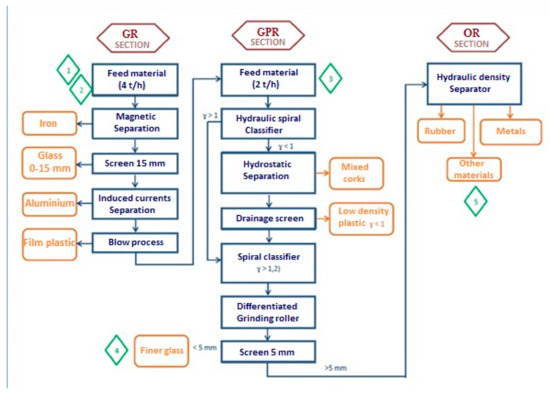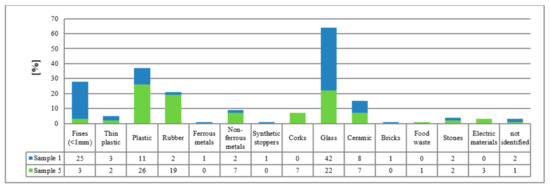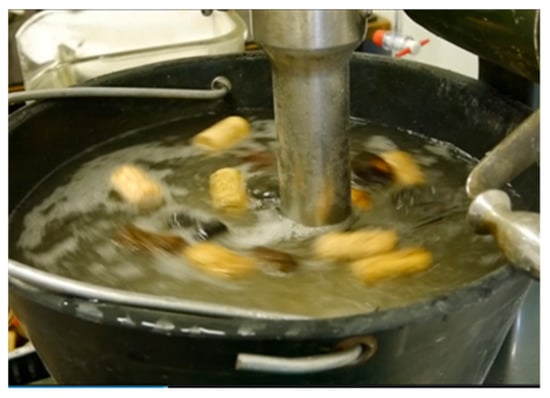Abstract
In recent times, the selection and treatment of glass waste are implemented in processing plants where a secondary raw material (SRM) named glass cullet, which is suitable for glass production, and a waste containing a high percentage of glass (glass waste2) is obtained. In the literature, there are many studies conducted on the recovery of the cullet, while few are the studies on the recovery of the waste that is produced by cullet processing. According to the 2013 Joint Research Centre (JRC) Reference report, the cullet produces savings in terms of energy and raw materials. However, it has a high current cost and its availability is becoming difficult, therefore its use is not always economically advantageous. The goal and strategy of the European Union is zero waste. For this purpose, further treatment of glass waste has been investigated. Through the industrial treatment of the glass waste2, a glass waste3 constituted again by an SRM made of glass is obtained together with a high quantity of presumed SRM (e.g., heavy plastic, corks, iron, non-ferrous metals, etc.). The process treatment separating these SRMs from the glass waste3 is, in this case, a pilot plant that needs to be optimized in order to reach an economic and sustainable industrial process solution. In particular, the materials to be recycled are exploitable product fractions with different particle sizes and physical properties (such as density, shape and resistance). This research is based on data collected from a North Italy process plant and is aimed at solving the issue of waste in this kind of process by implementing a pilot plant already present. Representative samples of feed material (glass waste3) and different products of the pilot plant have been analyzed. Moreover, laboratory tests were executed to improve separation efficiency and to valorize the different product fractions. A flow sheet of a new treatment plant has been developed and an economic evaluation has been made. The materials that will be separated in the new plant could be traded as SRM—e.g., plastics, metals, synthetic and cork stoppers—which constitute almost 90% of the total feed of the plant.
1. Introduction
Most of the glass recycled in Europe today comes from the collection of glass packaging from the public surface amounting to almost 74% of the total glass packaging generated [1].
The selection and treatment of the glass was completed in treatment plants where the waste was processed into the cullet (according to the US EPA [2] 2012 definition, this is glass that is crushed and ready to be re-melted), a secondary raw material (SRM) suitable for glass factories [3,4,5,6]. In particular, once the glass waste reaches the treatment plant, it is subjected mainly to the following treatments: manual sorting for elimination of foreign bodies, magnetic separation of ferrous metals, separation of non-ferrous metals by means of eddy currents, crushing by means of a roller mill, size classification with a vibrating screen, separation of light materials by means of cyclon and separation of glass into different colors using an optical sorter [7,8,9,10].
In each of the treatment steps ferrous and non-ferrous metals, papers, plastics, lithoids, etc., represent the waste of the process together with a considerable amount of glass due to the fact that 100% efficiency can never be reached in an industrial separation.
One of the main problems in Italy concerns the quality of the cullet. It is necessary to increase the quality and efficiency of the glass recycling value chain through efficient collection and recycling to obtain quality cullet ready to be transformed into new glass, without any further treatments [11].
During the first process of the separation of glass waste, two products are obtained: a secondary raw material (SRM) called glass cullet, which is suitable for the production of glass, and a waste that contains a high percentage of glass, in this context called glass waste2. The obtained cullet (glass2), which must meet the EU end-of-waste regulation and the specifications of the glass making industry, is delivered to the glass factories where the recycling process is completed: melting it for the production of new glass products. End-of-waste regulation encourages recycling, through a series of steps to condition the waste glass for further use, as for example collection, crushing, sorting, removal of contaminants, transportation and end-use [12].
The use of cullet produces savings in terms of energy and raw materials. However, it has a high current cost and its availability is becoming difficult, therefore its use is not always economically advantageous [13,14].
The plant object of this analysis, which produces glass2, produces about 3% of waste from all impurities usually present in glass waste and contained beyond the glass secondary materials such as light plastics, corks, synthetic stoppers, aluminum, iron, heavy plastic and rubber.
Through a second industrial separation treatment of these glass waste2, another glass waste is obtained, which we call in this context glass waste3. The glass waste3 consists of a glass SRM together with a high amount of presumed SRM (e.g., heavy plastic, corks, iron, non-ferrous metals, etc.). The recovery of the components of glass waste3 represents an economic and environmental value, according to the end-of-waste criteria.
Figure 1 schematically shows the separation step and the products obtained and specifically shows the difference between glass waste2 and glass waste3.

Figure 1.
Flowsheet of production of glass waste3 treated in the North Italy pilot plant.
All of these potential SRMs have estimated economic values, respectively, from 500€/t to 10€/t. Light plastic has the highest value among glass waste. In fact, according to COM (2015) [15], 614 final on the Circular Economy, and from COM (2018) [16], 28 final on “A European Strategy for Plastics in a Circular Economy” of the European Commission, the recycling of plastics is a key point in the Circular Economy. The use of this material in the European Union has grown steadily, but less than 30% is collected for recycling and the remaining 70% is destined to landfill and incineration [16].
Their resettlement on the market, in fact, allows both a reduction in costs due to not paying landfill fees, but also an economic return from their sale to potential re-users.
The aim of this research is to verify the efficiency of the pilot plant for the processing of glass waste3 in order to improve the separation technique and to recover a higher percentage of valuable SRM, according to EU goals and strategies [13].
2. Materials and Methods
2.1. Materials
Figure 2 shows a flow chart of the initial North Italy pilot plant for the treatment of glass waste3. Five samples were taken from different sections of this plant in order to characterize them and to optimize the process. The plant can be divided into three sections indicated as: GR (Glass Recovery), GPR (Glass Plastic Recovery) and OR (Other Recovery) of the North Italy process plant.

Figure 2.
Plant operation for the recovery of glass waste3: brown indicates the main section of the plant.
All samples were taken with a pile sampling using a shovel, e.g., by taking the material from different points of the pile.
Samples 1 and 2, almost identical to each other, constitute the final waste treatment processes that take place in the North Italy Cullet process plant and represent the plant feed. These two samples were collected from the same point of the plant in order to compare the results obtained, respectively, after manual and automatic sieving.
Sample 3 was taken from the feed of the GPR section and was constituted by material that was already subjected to some initial treatments such as: a magnetic separation to remove the ferrous parts present; a sieving with a 15 mm opening; an eddy current separation to eliminate the non-ferrous metal parts; a blow process to extract the light elements such as plastic film, paper and fabrics.
Sample 4, collected at the end of the GPR section, was the result of the following wet treatments: a hydraulic separation with spiral classifier enabling the division between light (less than the density of water) and heavy materials (greater density of water); a further hydrostatic separation; a drainage screening to remove part of the water present; a high pressure grinding roller [17], which is able to crush hard elements such as glass and flatten soft elements such as rubber.
The materials with a size of >5 mm fed the OR section where another wet separation based on density to separate rubber, metals and other materials occurred. Sample 5 was taken from the final waste pile of the plant.
2.2. Methods
Laboratory analysis consisted of an initial characterization of representative portions of the samples collected (sampling and characterization) and in the study of possible treatment of the materials to recovery (lab processing). In the following paragraphs, there are the descriptions of the methods used.
2.2.1. Laboratory Sampling
Coning and quartering was the method predominantly used in the laboratory for the sampling of the material and the riffle splitter apparatus was mainly used for smaller particle-sized material.
2.2.2. Samples Characterization
In order to characterize the samples taken from the different sections of the plant the following analyses were performed:
- -
- Particle size analysis
- -
- Classification by waste
- -
- Magnetic separation
- -
- Sink-float
The particle size analysis has been made sieving both in manual and in automatic method, then the different kind of waste have been classified both by means a macroscopic and microscopic view. Further characterizations haven been made by means of magnetic and density properties.
The magnetic separation was carried out manually by means of a magnet of 1 T at a distance of maximum 2 cm. The sink-float separation was carried out in water with the goal to identify the heavy and light plastic (with density, respectively, major and minor than one) (Figure 1).
2.2.3. Samples Processing
In a second step, in order to optimize the plant process and to increase the separation efficiency of the different materials, the following treatments were performed:
- -
- Bar sieving
- -
- Jigging separation
- -
- Bath extractor (new technological solution)
A bar sieve of 12.5 mm was used initially to separate the caps, both synthetic and cork stoppers, from all the other materials. In fact, those with a greater thickness are retained by the sieve, while the thinner ones pass through it.
The jig was used to separate light plastic, ceramic and glass on the basis of their density. It works with short cycles of upward water pulses passing through a fixed sieve. The pulses are repeated until the grains retained by the fixed sieve reached a good separation on the base of their density. Unlike previous researches [18,19,20], where flotation is the separation methodology, the jig concentrator is more environmentally friendly working only with fluid motion without the dangerous use of additives and collectors.
The bath extractor (Figure 3) represents a new laboratory test for lightweight plastic separation (sinking) of synthetic and cork stoppers (floats) needing only water to execute the separation, without the addition of chemical agents to improve the separation. The instrumentation is composed of a stator with a rotor inside (with an average rotational velocity of 1900 rpm), a grid and a tank containing water. The currents generated by the rotation of the rotor within the stator attract downward materials that are characterized by a density (ρ) slightly lower than those of water density (ρ = 0.8 − 0.9), while lighter materials float (ρ = 0.3 − 0.5). The rotor–stator system is essential for the generation of currents favorable to this kind of separation.

Figure 3.
The bath extractor separator.
3. Results and Discussion
3.1. Sample Characterization
From the particle size analysis and the sorting of waste type of the new North Italy Cullet process plant for the recovery of glass waste3, it is possible to point out some essential characteristics (Table 1).

Table 1.
Average size and distribution of main materials in the different samples collected.
The plant feed is characterized by materials with a predominant particle size of approximately 10 mm material; glass is about 40% of the material and is significantly present in the classes between 9.5 mm and 4.0 mm. The fine fraction is very abundant and should be removed before the next stage of the treatment process. The plastic represents slightly less than one-third of all the materials and is more present in larger classes (lightweight plastic), while heavy plastic prevails in the smaller ones. The caps are present only in the first classes, i.e., those over 16 mm.
Sample 3, collected from the second section of the plant (GPR), has an average size of between 16.0 mm and 6.3 mm. The fine fraction was significantly reduced but still represents a disturbing element for the processes. The non-ferromagnetic metals, as well as the plastic film, were still significantly present, which indicates a poor efficiency of the separator compared to induced currents and the blowing system. Finally, the plastic is the most abundant fraction and more present in the larger grain size classes, while glass is present in smaller amounts and mainly has dimensions of 6.3 mm.
The final product of the GPR section (Sample 4) had a particle size predominantly less than 5 mm and consisted of about 60% glass still containing 40% of impurities, thus representing a non-satisfactory result of the second treatment section.
The final product of the last section (Sample 5) is composed equally of glass, plastic and rubber, indicating an insufficient efficiency of the last separations.
In Figure 4, the results of classification by waste type of Samples 1 and 5 are shown. As can be noted, the percentage of glass decreased from 42% to 22%. Moreover, in Sample 5 (which represents the real waste of the plant at the present), there is a considerable amount (of about 20%) of plastic and rubber.

Figure 4.
Classification by waste type of Samples 1 and 5 from the Companies SASIL s.r.l. plant.
3.2. Separations by Density
In Table 2, the results of a jigging separation executed in the laboratory on one sample of about 2100 g consisting of glass, ceramic, stone and light plastic of a minimum dimension of 12.5 mm are shown.

Table 2.
Jigging separation of plastic from other materials with minimum dimension of 12.5 mm.
In particular, 106.5 g of plastic was separated from a total of 114.74 g on the jig top and on the jig bed, 1471.9 g was separated from a total of 1558.5 g. Consequently, a separation efficiency of 92% for plastic separation and 95% for glass was calculated.
Concerning the separation by means of the new bath extractor method, an efficiency of 90% was reached when collecting the stoppers (cork and synthetic) from the plastic with a density less than one (Figure 5).

Figure 5.
The bath extractor separator as a product of separation with stoppers (cork and synthetic).
3.3. Suggestions for the New Process Plant
By means of the new separation techniques used in the laboratory, it has been possible to design a new process plant for glass waste3.
Figure 6 shows the flow sheet of the processing treatment suggested for the new plant and the weight percentage estimated for the material separated. The main processing difference can be found from the products of the separation of the spiral classifier. Mixed corks and plastic such as PP (polipropilene), HDPE (high density polyethylene) and LDPE (low density polyethylene) (density less than one) will be separated by the new technology, named as the bath extractor. A further laser separation can be used for the separation of cork from synthetic stoppers. Concerning the mix of stone, rubber and plastic with a density higher than one (PVC, polivinyl chloride and PET, polyethylene terephthalate), representing the second product of the spiral classifier, jig separation on the two different products obtained will be performed after a screening separation at 12.5 mm.

Figure 6.
The new process plant suggested: apparatus and percentage of different materials obtained with the new plant.
Based on the flowsheet developed, the percentage amount of the products with an economic value obtained by the new plant is 87.5% of the total. In particular, they include ferrous materials, non-ferrous metals, glass fine, synthetic and cork stopper, low-density plastic, glass, ceramic and stone. Table 3 shows the percentage of the different materials separated with the new plant.

Table 3.
List of valuable materials obtained with the new process plant suggested.
Based on the mass of light plastic (for example PP, HDPE, LDPE) in Table 3, a plant processing 4 t/h of glass waste3 and 3200 h/y of production will have 9% of that material with a value of 500€/t, representing not only a consistent environmental value but also an economic advantage.
Table 4 shows the comparison between the products obtained with the new pilot plant and the feed of the actual plant (Sample 1). The new pilot plant improves the separation by differentiating the various types of plastics based on their density. Considering the glass fine not pure (<1 mm), a better separation system is observed for the new plant; the percentage of impure glass is 12.7% compared to 25% of Sample 1. Considering the valuable materials glass, ceramic, stone and brick, the new plant obtains a percentage of 59.6% divided into 46.4% for materials with a size dimension <12.5 mm and 13.1% for materials with a size dimension >12.5 mm, compared to 53% of Sample 1. It is also shown that there are no unidentified materials with the new system.

Table 4.
Material percentage comparison between new pilot plant and the feed of plant (Sample 1).
4. Conclusions
According to a study of 2019 [14], the use of 30% of cullet instead of virgin matter leads to a significant reduction in CO2 emissions. By increasing the quantity of recycled material to be used also considering glass waste3, there would be a further reduction of energy, costs and a reduction of waste produced in the glass industry.
The waste material of the North Italy Cullet process plant (glass waste3) consists of exploitable product fractions, resalable as SRM, which account for approximately 87% of the total input to the system and turn out to be glass, lightweight plastic, ferrous metals, non-ferrous metals and synthetic and cork stoppers. Plastic in film, heavy plastic and rubber, however, have less economic value: for this reason, they do not justify any recovery process.
In order to place the new SRM on the market, they must have a high degree of purity (average of 80%). Treatments such as magnetic separation, eddy current separations, sieving and gravimetric separations, which are able to differentiate the product fractions, are used. In particular, the new separation treatments suggested, such as jigging and bath extractor, are characterized by an efficiency higher than 90%.
All the performed separation treatments have given rise to a project for a new plant with a goal to primarily provide environmental benefits: a lower impact on the environment achieved by a lower use of raw materials, a lower consumption of energy and a reduced contribution of landfill material, as well as a decrease in the emissions generated by all processes. In addition, the sale of the obtained SRM would provide a considerable economic return, able to support all management costs and to provide a considerable annual gain.
Author Contributions
Data curation, R.B. and P.M.; Investigation, R.B. and P.M.; Methodology, R.B. and P.M.; Resources, L.Z.; Supervision, P.M.; Validation, P.M.; Writing—original draft, R.B.; Writing—review & editing, L.Z. All authors have read and agreed to the published version of the manuscript.
Funding
No funding was received for this research.
Acknowledgments
The authors are grateful to the staff of the North Italy Cullet Process Plant for their availability and collaboration.
Conflicts of Interest
The authors declare no conflicts of interest.
References
- EC EUROSTAT. 2019. Available online: https://ec.europa.eu/eurostat/tgm/refreshTableAction.do?tab=table&plugin=1&pcode=ten00062&language=en (accessed on 30 January 2019).
- US EPA. Glass, Common Wastes & Materials; US EPA: Washington, DC, USA, 2012. Available online: https://www.epa.gov/facts-and-figures-about-materials-waste-and-recycling/glass-material-specific-data (accessed on 22 April 2012).
- Approfondimenti Settoriali Dedicati alle Singole Filiere di Riciclo e Recupero—Vetro. Available online: https://www.fondazionesvilupposostenibile.org/wp-content/uploads/dlm_uploads/L%E2%80%99Italia-del-Riciclo-2019.pdf (accessed on 15 February 2020).
- ARPA PIEMONTE. 2016. Available online: https://www.arpa.piemonte.gov.it/approfondimenti/temi-ambientali/rifiuti (accessed on 14 November 2016).
- ARPA VENETO. 2016. Available online: http://www.arpa.veneto.it/temi-ambientali/rifiuti (accessed on 10 November 2016).
- Blengini, G.A.; Busto, M.; Fantoni, M.; Fino, D. Eco-efficient waste glass recycling: Integrated waste management and green product development through LCA. Waste Manag. 2012, 32, 1000–1008. [Google Scholar] [CrossRef] [PubMed]
- CoReVe. Riciclo del vetro, spazio all’innovazione. Ecoscienza 2012, 1, 52–53. [Google Scholar]
- CoReVe. Piano Specifico di Prevenzione. 2015. Available online: https://coreve.it/wp-content/uploads/2018/06/risorse_documenti_download_pdf_434084139.pdf (accessed on 4 February 2020).
- CoReVe. Piano Specifico di Prevenzione. 2016. Available online: https://coreve.it/wp-content/uploads/2018/06/risorse_documenti_download_pdf_92.pdf (accessed on 4 March 2020).
- CoReVe. Piano Specifico di Prevenzione. 2017. Available online: https://coreve.it/wp-content/uploads/2019/01/170929-PSP-Settembre-2017.pdf (accessed on 4 February 2020).
- Testa, M.; Malandrino, O.; Sessa, M.R.; Supino, S.; Sica, D. Long-Term Sustainability from the Perspective of Cullet Recycling in the Container Glass Industry: Evidence from Italy. Sustainability 2017, 9, 1752. [Google Scholar] [CrossRef]
- Vieitez, E.R.; Eder, P.; Villanueva, A.; Saveyn, H. End-of-Waste Criteria for Glass Cullet: Technical Proposals. EUR 25220 EN. 2011. Available online: https://publications.jrc.ec.europa.eu/repository/bitstream/JRC68281/jrc68281.pdf (accessed on 4 February 2020).
- Scalet, B.M.; Garcia Munoz, M.; Sissa, A.; Roudier, S.; Delgado Sancho, L. Best Available Techniques (BAT) Reference Document for the Manufacture of Glass: Industrial Emissions Directive 2010/75/EU:(Integrated Pollution Prevention and Control); Publications Office of the European Union: Brussels, Belgium, 2013. [Google Scholar] [CrossRef]
- Butler, J.H.; Hooper, P.D. Chapter 15—Glass Waste. In Waste, 2nd ed.; Elsevier: Amsterdam, The Netherlands, 2019; pp. 307–322. [Google Scholar] [CrossRef]
- European Commission. COM 2015 614 Closing the Loop—An EU Action Plan for the Circular Economy; European Commission: Brussels, Belgium, 2015; p. 23. [Google Scholar]
- European Commission. COM 2018 28 An European Strategy for Plastics in a Circular Economy; European Commission: Brussels, Belgium, 2018; p. 18. [Google Scholar]
- Wills, B.A.; Finch, J. Wills’ Mineral Processing Technology: An Introduction to the Practical Aspects of Ore Treatment and Mineral Recovery; Elsevier: Amsterdam, The Netherlands, 2016. [Google Scholar]
- Hori, K.; Tsunekawa, M.; Ueda, M.; Hiroyoshi, N.; Ito, M.; Okada, H. Development of a new gravity separator for plastics—A hybrid-jig. Mater. Trans. 2009, 50, 2844–2847. [Google Scholar] [CrossRef]
- Burat, F.; Güney, A.; Kangal, M.O. Selective separation of virgin and post-consumer polymers (PET and PVC) by flotation method. Waste Manag. 2009, 29, 1807–1813. [Google Scholar] [CrossRef] [PubMed]
- Salerno, D.; Jordão, H.; La Marca, F.; Carvalho, M.T. Using factorial experimental design to evaluate the separation of plastics by froth flotation. Waste Manag. 2018, 73, 62–68. [Google Scholar] [CrossRef] [PubMed]
© 2020 by the authors. Licensee MDPI, Basel, Switzerland. This article is an open access article distributed under the terms and conditions of the Creative Commons Attribution (CC BY) license (http://creativecommons.org/licenses/by/4.0/).